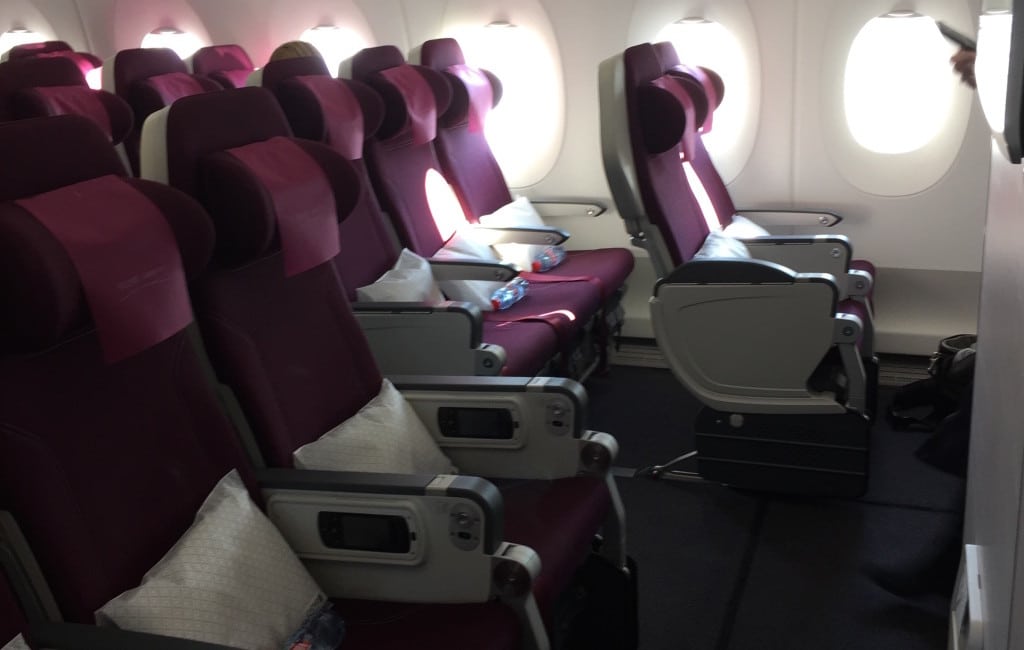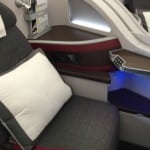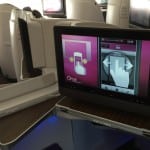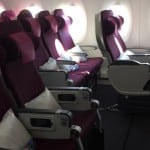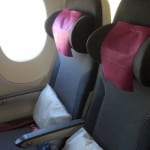Skift Take
If Airbus meets production projections, this is aircraft is set up to give Boeing’s 787 Dreamliner a run for its money.
- Qatar’s A350XWB Business Class/FCMedia
- Qatar’s A350XWB Business Class/FCMedia
- Qatar’s A350XWB Economy/FCMedia
- Qatar’s A350XWB Economy/FCMedia
- View of Qatar’s fourth A380 and A350 XWB sharklet/FCMedia
During the reveal of the new Qatar A350XWB in Toulouse, Airbus’ Dr. Kiran Rao, Executive Vice President, Strategy and Marketing highlighted that adding this aircraft to its fleet helps Qatar position itself as global axis hub, out of its new Hamad International Airport in Doha.
“Qatar Airways,” said Dr. Rao, “[is] geographically ideally suited to cover the entire world. With only one stop, most passengers can get to anywhere in the world through the Qatar hub that has been created for the A350, and for the A380, [combined with] the A330s and A320s that they have in service at the moment.”
Skift spoke with airline industry analyst Dr. Addison Schonland, Parter at aviation consultancy AirInsight, at the launch event in Toulouse on December 22, who shared insights on the feasibility of this plan.
Dr. Schonland explained how the addition of this aircraft helps the airline’s strategy to get ahead, as competition heats up in the Gulf between Qatar Airways, Etihad and Emirates.
“Qatar, Etihad and Emirates are all in a battle to acquire all the traffic they can. Their ambitions are huge with large orders and hopes for attracting traffic. To an extent they have been successful. But the older carriers are responding competitively as the threat becomes clear,” he tells us.
As Dr. Schonland sees it, “[Qatar] can’t outdo Emirates in size, so it seems to want to do so via passenger experience. This is a logical move. Without the fleet of A380s that Emirates has, Qatar can’t compete on volume. It competes on its strengths, which are cabin and service.”
While Qatar’s A380s, the first of which the airline received in Hamburg this September, feature a First Class cabin, with ample seating capacity for 48 in Business Class, Qatar’s A350XWB is a two-class configuration: Business and Economy.
The A350XWB seats 36 in Business Class and 247 Economy Class passengers. The Economy cabin is divided by service galleys, which reduces the overwhelming visual impact of multiple identical rows of seats. The airline also employed color changes in the Economy seat covers for this purpose. During our fly tour experience, we found the Economy seats comfortable, featuring adjustable headrests, ample leg room and state-of-the-art Thales Avant System In-Flight Entertainment. We also enjoyed reduced cabin noise, which allowed comfortable conversation with colleagues, and plenty of natural light from the aircraft’s larger windows. All these features made the journey pleasant, regardless of cabin class.
At present, Qatar flies to over 130 destinations on six continents, and intends to continue adding routes.
Dr. Schonland believes adding the A350XWB to its fleet was a smart move for Qatar Airways.
“With the A350XWB, Qatar has the tool to accomplish its task of moving market share away from competition,” Dr. Schonland says. “Its lower costs and range make it potentially disruptive and a cash generating machine.”
The question is whether Airbus can keep up with its production schedule. Qatar has ordered 80 A350XWBs, and the manufacturer has orders on the books to fulfill from other airlines. Airbus insists it can meet this demand, and His Excellency Mr. Akbar Al Baker, Qatar Airways Chief Executive, made it clear he will hold Airbus to that promise.
The Daily Newsletter
Our daily coverage of the global travel industry. Written by editors and analysts from across Skift’s brands.
Have a confidential tip for Skift? Get in touch
Tags: airbus, doha, qatar, qatar airways
Photo credit: Qatar's A350XWB Economy class. FCMedia
